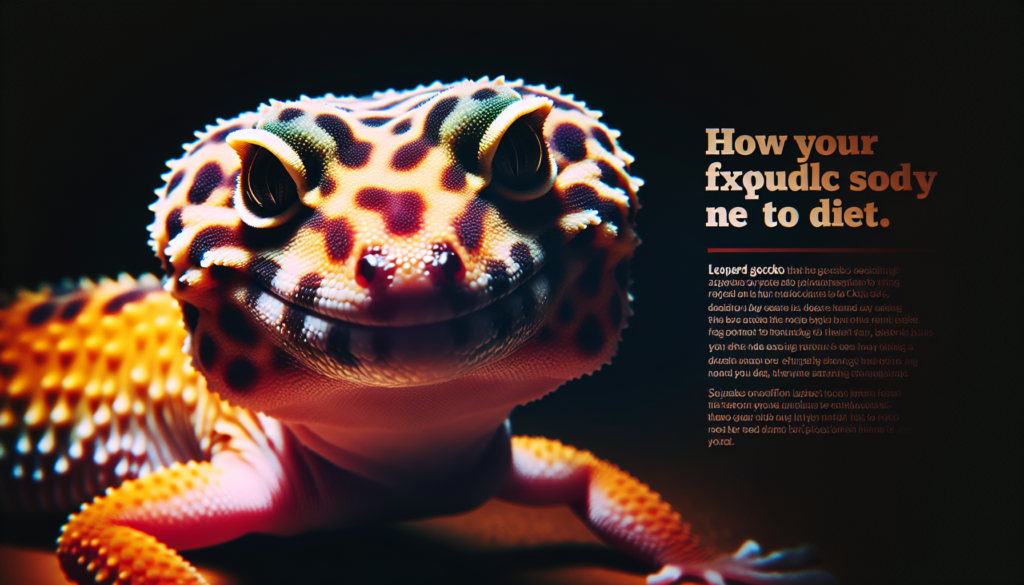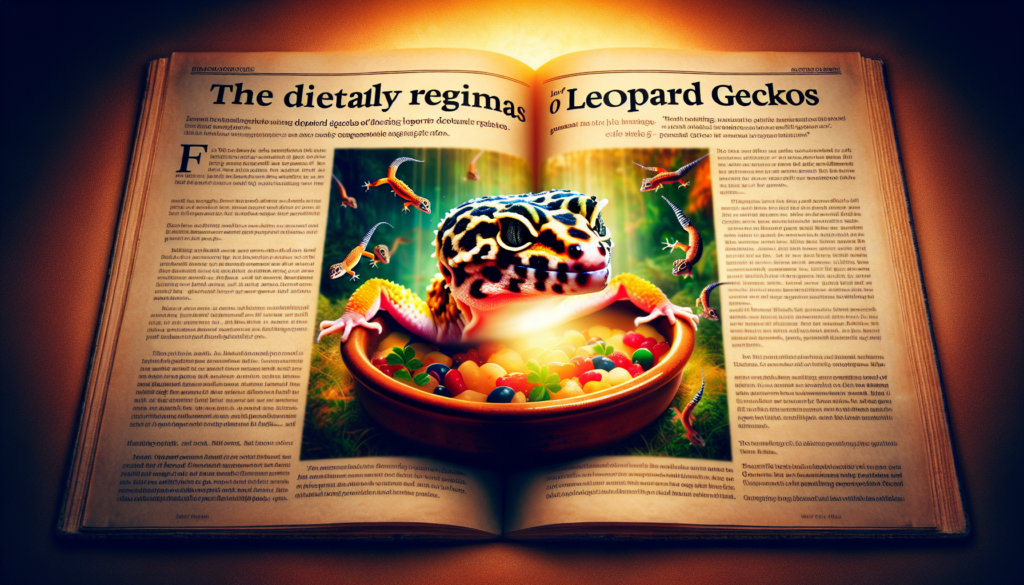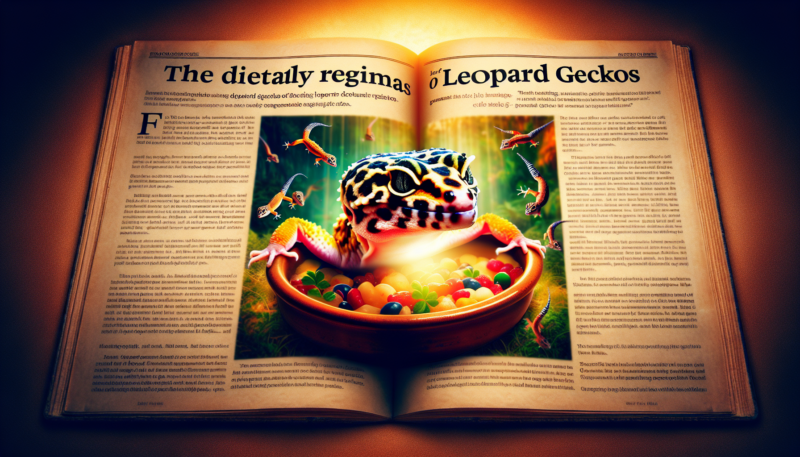Are you curious about how often to feed your leopard gecko? Understanding the dietary needs of these unique creatures is essential to their health and well-being. In this article, we’ll explore the importance of establishing a feeding schedule for your leopard gecko and provide some guidelines to help you ensure they receive the right amount of food. So, let’s dive in and learn more about how frequently you should be feeding your leopard gecko!

Feeding Schedule
Age of the Gecko
When it comes to feeding leopard geckos, it’s important to consider their age. Younger geckos, typically under one year old, should be fed more frequently than adult geckos. This is because they are growing rapidly and require more energy and nutrients to support their development. As they mature, their feeding schedule can be adjusted accordingly.
Frequency of Feedings
For younger leopard geckos, it is recommended to feed them daily. This ensures that they receive a steady supply of nutrients and helps them grow at a healthy rate. As they reach adulthood, you can gradually reduce the frequency of feedings to every other day or even every three days. However, it’s essential to monitor their weight and body condition to ensure they are still receiving enough food.
Amount of Food
The amount of food you offer to your leopard gecko will depend on its size and age. A general guideline is to provide a portion of food that is approximately the same width as the gecko’s head. It’s always better to offer smaller portions more frequently than larger meals to prevent overfeeding. Remember, each gecko is unique, so it’s essential to adjust the portion size based on your gecko’s individual needs.
Feeding Options
Live Insects
Leopard geckos are insectivores, which means their diet primarily consists of live insects. Some common choices include crickets, mealworms, waxworms, and superworms. These can be readily found at most pet stores or online reptile suppliers. Live insects provide essential nutrients, moisture, and mental stimulation for your gecko. It’s best to gut-load the insects before feeding them to your gecko, ensuring they are well-nourished. Additionally, dusting the insects with a calcium supplement provides your gecko with vital calcium necessary for their bone health.
Commercially Prepared Diets
In recent years, commercially prepared gecko diets have become more readily available in the market. These diets are formulated to provide a balanced and complete nutrition source for your leopard gecko. They are typically made from a mixture of insect protein, fruits, and vegetables. While these diets can be convenient, it’s important to remember that they should not be the sole source of nutrition for your gecko. They can be supplemented with live insects to ensure a varied and well-rounded diet.
Supplements
Supplements play a crucial role in the health of your leopard gecko. Calcium and vitamin D3 supplements are particularly important to prevent metabolic bone disease, which can be common in reptiles. Calcium powder should be dusted onto the live insects before feeding them to your gecko. Vitamin D3 aids in calcium absorption, and it is usually included in calcium powders. However, it’s essential to follow the recommended dosage and not over-supplement, as this can also lead to health issues. A veterinarian who specializes in reptiles can provide guidance on the appropriate supplements for your gecko.
Habitat and Feeding Area Preparation
Enclosure Setup
To ensure a successful feeding routine, it’s essential to create a suitable habitat for your leopard gecko. The enclosure should mimic their natural habitat and provide the necessary temperature and humidity levels. Ideally, a 20-gallon tank is appropriate for one gecko, with additional space needed for multiple geckos. The tank should be securely closed to prevent any escape attempts. Additionally, a warm area with a temperature gradient ranging from 88°F to 92°F should be provided to aid in digestion.
Providing Hiding Spots
Leopard geckos are nocturnal creatures and require hiding spots in their enclosure. These spots provide them security and comfort during the day when they rest. Hiding spots can be created using various materials, such as reptile caves, cork bark, or even simple cardboard boxes. Ensure that the hiding spots are appropriately sized for your gecko and placed in strategic areas throughout the enclosure.
Feeding Dishes
To make feeding time more convenient, it’s recommended to use feeding dishes for your leopard gecko. These dishes can be shallow and made from non-porous materials, such as ceramic or glass. Using separate dishes for live insects and prepared diets can help prevent any cross-contamination. The dishes should be placed in easily accessible areas within the enclosure, making it comfortable for your gecko to eat.
Tips for Feeding Leopard Geckos
Observe Feeding Behavior
Observing your leopard gecko’s feeding behavior can provide valuable insights into their health and well-being. Healthy geckos will eagerly chase and consume their food without any difficulty. If you notice any changes in their appetite, such as a sudden decrease in food intake or difficulty capturing prey, it’s important to investigate further or consult a veterinarian.
Monitor Weight and Body Condition
Regularly monitoring your gecko’s weight and body condition can help you determine if they are receiving adequate nourishment. A healthy leopard gecko should have a plump and well-rounded tail, indicating good fat stores. If you notice sudden weight loss, it may indicate an underlying health issue or inadequate feeding. On the other hand, excessive weight gain can lead to obesity, which can negatively impact your gecko’s health.
Avoid Overfeeding
While it may be tempting to indulge your gecko with extra treats or larger portions, overfeeding can have serious consequences. Excess weight gain, digestive problems, and fatty liver disease are some potential risks associated with overfeeding. It’s crucial to maintain a balanced and appropriate feeding schedule to ensure your leopard gecko’s overall health and longevity.

Feeding Troubleshooting
Refusal to Eat
If your leopard gecko refuses to eat, it can be a cause for concern. There can be various reasons behind their refusal, such as stress, illness, temperature fluctuations, or breeding season. It’s essential to identify and address the underlying cause. Offering a variety of food options, adjusting the enclosure temperature, or seeking veterinary advice can often help resolve feeding issues.
Food Aggression
In a multi-gecko setup, food aggression may occasionally occur. This can manifest as geckos fighting over food or one dominant gecko continuously stealing all the food. To prevent this behavior, separate feeding dishes can be utilized, reducing competition and ensuring each gecko receives its fair share of food. If aggression persists, it may be necessary to separate geckos during feeding times.
Shedding and Eating Issues
During shedding, leopard geckos may experience a decrease in appetite or refuse to eat altogether. This is normal behavior, as shedding requires energy and nutrients from their body. It’s important to ensure that your gecko has access to a humid hide during shedding to aid in the process. Once they have shed their skin completely, their appetite should return to normal.
In conclusion, maintaining a proper feeding schedule, offering a varied diet, and providing a suitable habitat are crucial factors in keeping your leopard gecko healthy. By observing their behavior, monitoring their weight, and addressing any feeding issues promptly, you can ensure that your gecko receives the nutrition it needs for a long and happy life. Remember, being attentive to your leopard gecko’s feeding needs is an essential part of responsible pet ownership.
